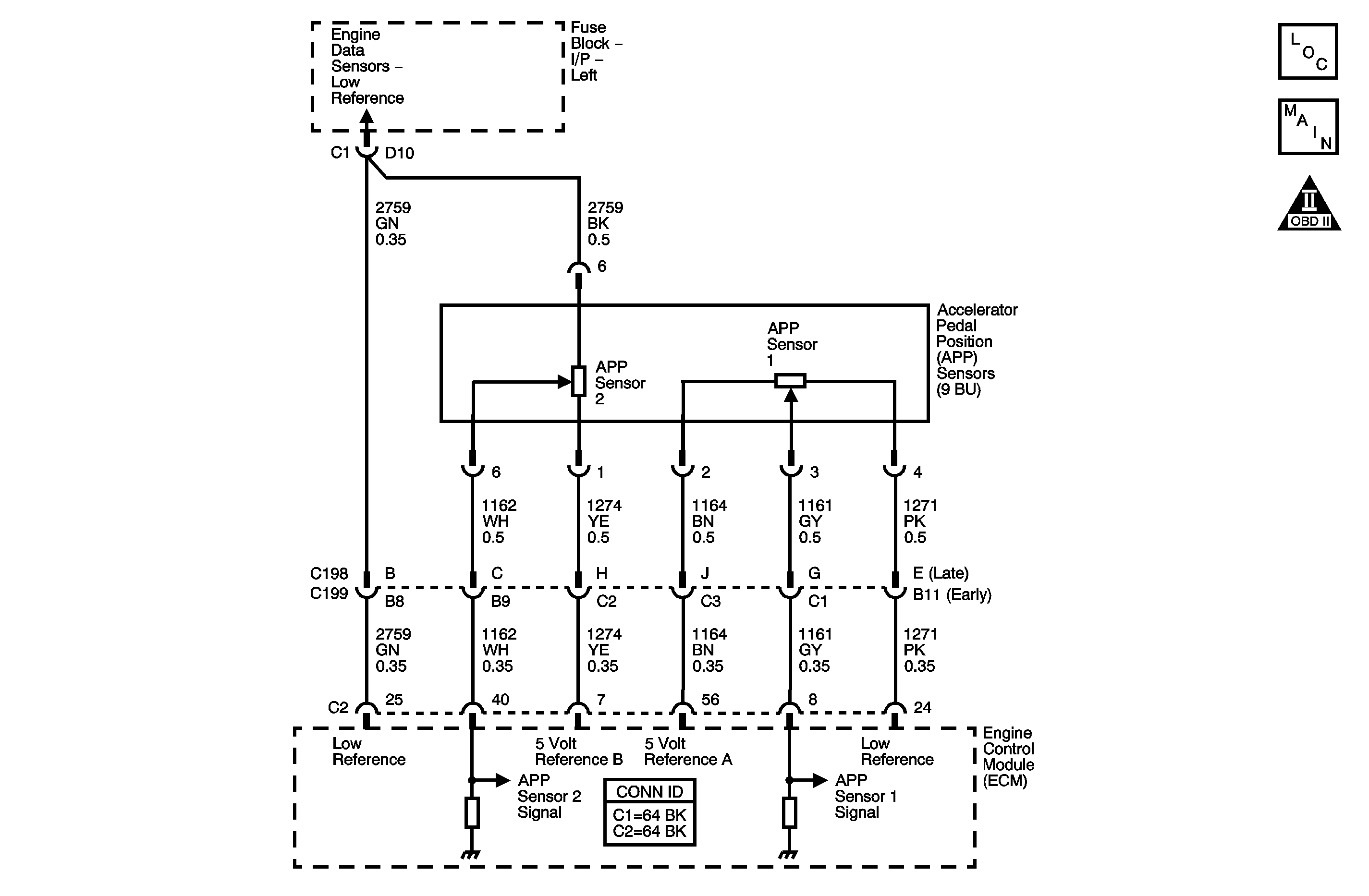
Circuit Description
The accelerator pedal position (APP) sensor is made up of two sensors that are housed inside one assembly. The engine control module (ECM) supplies a separate 5-volt reference and the low reference circuit for each of the sensors. The 5-volt reference for APP sensor 1 is supplied from the same source in the ECM as the 5-volt reference for the mass air flow (MAF) sensor and the fuel tank pressure (FTP) sensor. The 5-volt reference voltage for all of the sensors is supplied on separate ECM terminals, but the terminals are connected internally to a voltage supply. The APP sensor 1 sends a signal from the sensor to the ECM indicating the accelerator pedal position. The ECM actuates the throttle plates based on this information. The APP sensor 1 signal voltage increases as the pedal is applied. If the ECM detects that the signal voltage is less than 0.84, DTC P1277 will set.
Conditions for Running the DTC
| • | The battery voltage is more than 10 volts. |
| • | The accelerator pedal is not in the rest position. |
Conditions for Setting the DTC
The APP sensor 1 voltage is less than 0.84 volt for more than 140 milliseconds.
Action Taken When the DTC Sets
| • | The control module illuminates the malfunction indicator lamp (MIL) when the diagnostic runs and fails. |
| • | The control module records the operating conditions at the time the diagnostic fails. The control module stores this information in the Freeze Frame and/or the Failure Records. |
| • | The control module commands the TAC system to operate in the Reduced Engine Power mode. |
| • | A message center or an indicator displays Reduced Engine Power. |
| • | Under certain conditions the control module commands the engine OFF. |
Conditions for Clearing the MIL/DTC
| • | The control module turns OFF the malfunction indicator lamp (MIL) after 3 consecutive ignition cycles that the diagnostic runs and does not fail. |
| • | A current DTC, Last Test Failed, clears when the diagnostic runs and passes. |
| • | A history DTC clears after 40 consecutive warm-up cycles, if no failures are reported by this or any other emission related diagnostic. |
| • | Clear the MIL and the DTC with a scan tool. |
Diagnostic Aids
Use the J 35616 Connector Test Adapter Kit for any test that requires probing the ECM harness connector or a component harness connector. For intermittent conditions, refer to Intermittent Conditions .
Step | Action | Values | Yes | No | ||||||||
|---|---|---|---|---|---|---|---|---|---|---|---|---|
Schematic Reference: Engine Controls Schematics Connector End View Reference: Engine Control Module Connector End Views or Engine Controls Connector End Views | ||||||||||||
1 | Did you perform the Diagnostic System Check-Engine Controls? | -- | Go to Step 2 | |||||||||
2 |
Is the APP sensor 1 voltage less than the specified value? | 0.8 V | Go to Step 5 | Go to Step 3 | ||||||||
3 |
Does the DTC fail this ignition? | -- | Go to Step 5 | Go to Step 4 | ||||||||
4 |
Did the DTC fail this ignition? | -- | Go to Step 14 | Go to Diagnostic Aids | ||||||||
5 |
Is the voltage within the specified range? | 4.8-5.2 V | Go to Step 6 | Go to Step 7 | ||||||||
6 |
Is the APP sensor 1 voltage within the specified value? | 4.8-5.2 V | Go to Step 11 | Go to Step 9 | ||||||||
7 |
Is the voltage within the specified range after disconnecting any component? | 4.8-5.2 V | Go to Step 13 | Go to Step 8 | ||||||||
8 |
Did you find and correct the condition? | -- | Go to Step 16 | Go to Step 10 | ||||||||
9 |
Did you find and correct the condition? | -- | Go to Step 16 | Go to Step 12 | ||||||||
10 |
Did you find and correct the condition? | -- | Go to Step 16 | Go to Step 12 | ||||||||
11 | Test for an intermittent and for a poor connection at the APP sensor. Refer to Testing for Intermittent Conditions and Poor Connections and Connector Repairs in Wiring Systems. Did you find and correct the condition? | -- | Go to Step 16 | Go to Step 14 | ||||||||
12 | Test for an intermittent and for a poor connection at the engine control module (ECM). Refer to Testing for Intermittent Conditions and Poor Connections and Connector Repairs in Wiring Systems. Did you find and correct the condition? | -- | Go to Step 16 | Go to Step 15 | ||||||||
13 | Replace the component. Refer to the appropriate replacement procedure. Did you complete the replacement? | -- | Go to Step 16 | -- | ||||||||
14 | Replace the accelerator pedal assembly. Refer to Accelerator Pedal Position Sensor Replacement . Did you complete the replacement? | -- | Go to Step 16 | -- | ||||||||
15 | Replace the ECM. Refer to Engine Control Module Replacement . Did you complete the replacement? | -- | Go to Step 16 | -- | ||||||||
16 |
Did the DTC fail this ignition? | -- | Go to Step 2 | Go to Step 17 | ||||||||
17 | Observe the Capture Info with a scan tool. Are there any DTCs that have not been diagnosed? | -- | System OK | |||||||||
